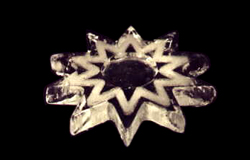Ice Sculptor
Corporate dinners, television shoots, trade shows and weddings may
not have much in common -- unless you ask a professional ice sculptor.
 |
| Ice sculptors use very large power tools to create very intricate
designs in the ice. |
| Courtesy of: Iceculture |
Ice sculpture began as a functional and decorative cooling system over
200 years ago and has evolved into an intricate art form. When French chefs
began sculpting ice to create containers that would keep food cool on the
buffet table, they had no way of predicting the worldwide interest their creation
would enjoy.
Alice Connelly is the executive director of the National Ice Carving Association
(NICA) in Oak Brook, Illinois. A retired carver herself, Connelly estimated
that the sculpting business has grown about 30 percent each year since 1995.
It is exactly this growth that demanded the creation of NICA in 1987. A
group of sculptors went to competitions throughout the Midwest and found rules
and judging criteria were inconsistent. They decided to set up an association
to standardize rules and guidelines for ice carving and created NICA.
Since then, Connelly's organization has attracted over 600 members worldwide,
many of whom work as professional ice sculptors or gourmet chefs.
Thomas Hicks is a member of NICA and the owner of Art in Ice in San Diego,
California. Like a lot of sculptors, Hicks trained as an apprentice for three
years with a California-based sculptor before starting his own business. And
he didn't get into ice sculpting through an art school or to work in a trade.
Hicks began carving ice in his spare time while working for the Department
of Justice, after an 11-year stint with the United States Marine Corps. For
Hicks, starting his own company was a fulfilling and welcome challenge.
"I like working for myself. I like being able to do something artistic,
and it's always nice when you deliver a piece and people tell you what a great
job you did."
Not all ice sculptors come from a trained artistic background. Many start
out sculpting as a hobby but soon realize it's a fun and creative way to make
a living. So once you have the ability, how does a sculptor go about starting
a business?
Many professional sculptors attend trade shows. Hicks says he attends between
four and five wedding shows a year to drum up new clients. He also says that
a constantly evolving portfolio is necessary to help the company grow.
"I have increased my business every year. I add new pieces to my portfolio,
learn different techniques for carving, and try to improve my ability overall."
And ice sculpting may be more lucrative than you might imagine. Hicks says
he has had a few jobs in the $2,500 range, and while apprenticing worked on
a job for a television commercial that totaled about $20,000.
A lot of orders come from everyday people celebrating weddings or anniversaries.
But Hicks also has an impressive list of corporate clients like Coca-Cola
and Harley-Davidson.
Sculpting is a precise skill. Most clients probably don't realize how exact
the work has to be -- especially considering it is often done with very large
power tools. Ice sculpting hovers between a fine art and a highly skilled
trade. It demands both talent and discipline.
 |
| Ice sculptures are becoming a more common sight at modern weddings.
This is a sculpture of a bride and groom. |
| Courtesy of: Iceculture |
For Hicks, his work draws from both his artistic and practical skills.
"It is an art form, carved in four dimensions, the fourth being time. But
if you don't practice good business techniques and promote your business,
it will be hard to be successful."
To do such precise work, sculptors rely on a variety of tools. But as Hicks
admitted, sculptors will try just about any tool on their work.
"Number one is the chainsaw. But we use many different sized chisels, routers,
grinders, handsaws, irons, liquid nitrogen for freezing. We're a very creative
and inquisitive bunch. We will try almost anything on the ice."
Sometimes the tools available just don't quite do the trick. Because each
sculpture is developed in consultation with the client, some pieces demand
special attention and innovative tools.
This constant need for innovation keeps sculptors on the cutting edge of
their industry. Technological advances, the use of color and unusual, creative
work all help draw in new clients. For Hicks, the Internet has become a helpful
tool for advertising his talents.
"The Internet is becoming more and more useful for clients finding you,
and it's a great way to show them examples of your work, as this is a very
visual medium," Hicks explains. But perhaps more important, he added, is how
your own work represents you to potential clients.
When customers are spending anywhere from a few hundred to several thousand
dollars on a detailed order, top quality is a necessity. "Most important is
word of mouth. Every great event that I do is a potential client. So always
do your best work -- the actual sculpture is the best advertising that you
can do."
Links
Iceculture
Check out their fruit and vegetable designs that allow colorful
images to be set into large ice blocks
Global Ice Co.
Open for calls 24 hours, this British site uses every kind of
ice imaginable
Back to Career Cluster